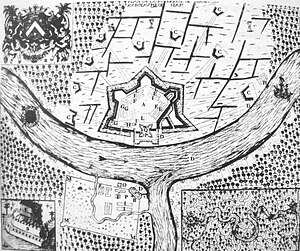| Siege of Bangkok | |||||||
|---|---|---|---|---|---|---|---|
| Part of the Siamese revolution of 1688 | |||||||
 Siege of the French fortress (A) by Siamese troops and batteries (C), in Bangkok, 1688. The enclosure of the village of Bangkok represented in the lower left corner (M) is today's Thonburi.[1] | |||||||
| |||||||
| Belligerents | |||||||
|
| |||||||
| Commanders and leaders | |||||||
|
|
| ||||||
| Strength | |||||||
| 40,000 | 1,000[3] | ||||||
| Casualties and losses | |||||||
| An estimated 100 Thai soldiers were killed.[citation needed] | [citation needed]. 4 French soldiers were shot to death.
Many french troops captured 4 died from wounds | ||||||
The siege of Bangkok was a key event of the Siamese revolution of 1688, in which the Kingdom of Siam ousted the French from Siam. Following a coup d'état, in which the pro-Western king Narai was replaced by Phetracha, Siamese troops besieged the French fortress in Bangkok for four months. The Siamese were able to muster about 40,000 troops, equipped with cannon, against the entrenched 200 French troops, but the military confrontation proved inconclusive. Tensions between the two belligerents progressively subsided, and finally a negotiated settlement was reached allowing the French to leave the country.[4]
The Siege of Bangkok would mark the end of French military presence in Siam, as France was soon embroiled in the major European conflicts of the War of the League of Augsburg (1688–1697), and then the War of the Spanish Succession (1701–1713/14). With the end of the siege, a long period started during which Siam would remain suspicious of Western intervention. Only a few French missionaries were allowed to remain, while trade continued on a limited level with other European countries such as Portugal, the Dutch Republic and England.
- ^ Vollant des Verquains, in Smithies 2002, p.95-96
- ^ Jean Vollant des Verquains History of the revolution in Siam in the year 1688, in Smithies 2002, pp. 95–96.
- ^ Tourism Division; Culture, Sports and Tourism Department; BMA(2012) 2nd ed. กรุงเทพฯ บนฝั่งธานแห่งวัฒนธรรม. Krung Thep Maha Nakhon: Rumthai Press.page 34
- ^ Siam: An Account of the Country and the People, Peter Anthony Thompson, 1910 p.28